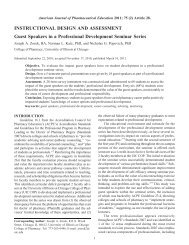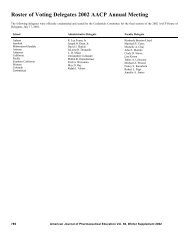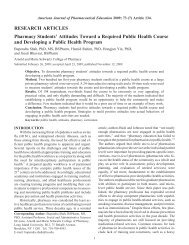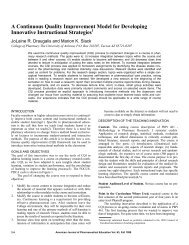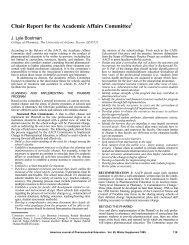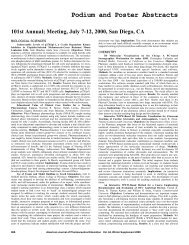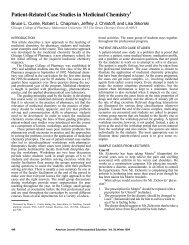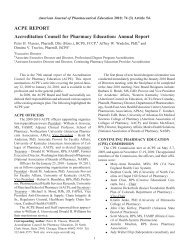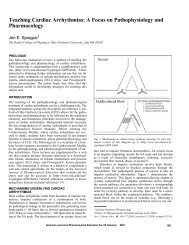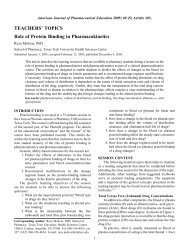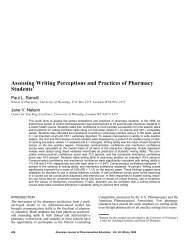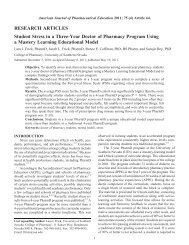Pharmacy Students' Perceptions of Pharmaceutical Care in ... - AJPE
Pharmacy Students' Perceptions of Pharmaceutical Care in ... - AJPE
Pharmacy Students' Perceptions of Pharmaceutical Care in ... - AJPE
Create successful ePaper yourself
Turn your PDF publications into a flip-book with our unique Google optimized e-Paper software.
American Journal <strong>of</strong> <strong>Pharmaceutical</strong> Education 2004; 68 (1) Article 4.<br />
RESEARCH ARTICLES<br />
<strong>Pharmacy</strong> Students’ <strong>Perceptions</strong> <strong>of</strong> <strong>Pharmaceutical</strong> <strong>Care</strong> <strong>in</strong> Retail and<br />
Cl<strong>in</strong>ic Sett<strong>in</strong>gs<br />
Lesa Lawrence, PhD, Just<strong>in</strong> Sherman, PharmD, Edw<strong>in</strong> Adams, PharmD, and Shravanthi Gandra,<br />
MPharm<br />
School <strong>of</strong> <strong>Pharmacy</strong>, College <strong>of</strong> Health Sciences, The University <strong>of</strong> Louisiana at Monroe<br />
Submitted October 7, 2002; accepted July 28, 2003; published March 5, 2004.<br />
Objectives. To determ<strong>in</strong>e whether completion <strong>of</strong> a patient counsel<strong>in</strong>g course improved<br />
pharmacy students’ perceptions <strong>of</strong> the importance <strong>of</strong> pharmaceutical care and whether there<br />
was a difference <strong>in</strong> students’ perceptions <strong>of</strong> pharmaceutical care provided <strong>in</strong> retail sett<strong>in</strong>gs<br />
compared to that provided <strong>in</strong> cl<strong>in</strong>ic sett<strong>in</strong>gs.<br />
Methods. A pre-course and post-course survey <strong>in</strong>strument was designed to measure students’<br />
perceptions <strong>of</strong> the importance <strong>of</strong> pharmacists’ perform<strong>in</strong>g 20 items describ<strong>in</strong>g pharmaceutical<br />
care. Also, each student wrote a technical report describ<strong>in</strong>g a counsel<strong>in</strong>g encounter<br />
observed between a pharmacist and a patient. This report was subject to content<br />
analysis.<br />
Results. After tak<strong>in</strong>g a patient counsel<strong>in</strong>g course, students perceived five out <strong>of</strong> 20 pharmaceutical<br />
care tasks performed by pharmacists to be most important. Also, student analyses<br />
<strong>of</strong> pharmacist/patient <strong>in</strong>teractions <strong>in</strong>dicated that barriers to communication were fewer,<br />
students’ experiences were more educational, and privacy, monitor<strong>in</strong>g and assessment were<br />
better <strong>in</strong> cl<strong>in</strong>ic sett<strong>in</strong>gs. Accord<strong>in</strong>g to students’ perceptions, the application <strong>of</strong> pharmaceutical<br />
care was different between cl<strong>in</strong>ic and retail sett<strong>in</strong>gs.<br />
Conclusions. Therefore, teach<strong>in</strong>g the concept <strong>of</strong> pharmaceutical care and <strong>in</strong>corporat<strong>in</strong>g it<br />
<strong>in</strong>to a patient counsel<strong>in</strong>g course is more educational when a cl<strong>in</strong>ic sett<strong>in</strong>g is used.<br />
Keywords: pharmaceutical care, patient counsel<strong>in</strong>g, cl<strong>in</strong>ic, community pharmacy<br />
INTRODUCTION<br />
<strong>Pharmaceutical</strong> care has been described as a multifaceted<br />
process that results <strong>in</strong> positive outcomes for patients<br />
through identification, resolution, and prevention <strong>of</strong> drugrelated<br />
problems. 1 For many years, pharmacists have been<br />
<strong>in</strong> transitional roles, mov<strong>in</strong>g toward a target <strong>of</strong> provid<strong>in</strong>g<br />
pharmaceutical care. Through strategic plann<strong>in</strong>g, pharmacy<br />
schools anticipated this transition and have begun<br />
prepar<strong>in</strong>g students for evolv<strong>in</strong>g pr<strong>of</strong>essional roles with<br />
more patient-centered care and counsel<strong>in</strong>g, expanded drug<br />
use monitor<strong>in</strong>g, appropriate drug selection, and responsibility<br />
for patient outcomes.<br />
<strong>Pharmacy</strong> schools have a duty to provide pharmaceutical<br />
care education for students regardless <strong>of</strong> future practice<br />
sett<strong>in</strong>gs s<strong>in</strong>ce the fundamental elements exist <strong>in</strong> a variety<br />
<strong>of</strong> sett<strong>in</strong>gs. 1 Teach<strong>in</strong>g methods should be designed to<br />
<strong>in</strong>struct students how to provide pharmaceutical care with<br />
a process to evaluate students’ ability to provide this care. 2<br />
Projects implemented to evaluate the provision <strong>of</strong> pharma-<br />
Correspond<strong>in</strong>g Author: Lesa Lawrence, PhD. Address:<br />
School <strong>of</strong> <strong>Pharmacy</strong>, College <strong>of</strong> Health Sciences, The<br />
University <strong>of</strong> Louisiana at Monroe, Monroe, LA 71209. Tel:<br />
318-342-1715. Fax: 318-342-1606. E-mail: lawrence@ulm.edu<br />
1<br />
ceutical care <strong>in</strong> simulated sett<strong>in</strong>gs have been described <strong>in</strong><br />
the literature. 3<br />
Although pharmacy students are taught <strong>in</strong> the classroom,<br />
students should also be exposed to practice environments<br />
at an early stage <strong>in</strong> their curriculum. This will<br />
help empower them to practice <strong>in</strong> covenant relationships<br />
with patients. A national survey distributed to pharmacy<br />
school faculty who teach communication revealed that the<br />
most <strong>in</strong>novative programs teach communication skills<br />
early, with additional courses to <strong>in</strong>tegrate and re<strong>in</strong>forcement<br />
communication throughout the curriculum. 4 Furthermore,<br />
the respondents <strong>in</strong> the survey valued the use <strong>of</strong><br />
real patients and practitioners to assist <strong>in</strong> teach<strong>in</strong>g communication<br />
skills. This allowed students to view their learn<strong>in</strong>g<br />
experience with<strong>in</strong> the context <strong>of</strong> actual pharmacy practice.<br />
While pharmacy school educators are prepar<strong>in</strong>g<br />
graduates for greater roles <strong>in</strong> patient care, students may<br />
develop frustration because <strong>of</strong> a possible mismatch between<br />
what is taught and how pharmacists practice. 5 Some<br />
students may not perceive the value <strong>of</strong> education centered<br />
on pharmaceutical care <strong>in</strong> different practice environments.<br />
The attitudes and skills <strong>of</strong> pharmacists themselves may<br />
serve as barriers to provid<strong>in</strong>g pharmaceutical care. 6 Phar-
American Journal <strong>of</strong> <strong>Pharmaceutical</strong> Education 2004; 68 (1) Article 4.<br />
macy school educators are counter<strong>in</strong>g this perception <strong>of</strong><br />
pharmaceutical care as an ideal and not a reality by expos<strong>in</strong>g<br />
students to experienced practitioners who practice <strong>in</strong> a<br />
variety <strong>of</strong> sett<strong>in</strong>gs and by us<strong>in</strong>g actual patients <strong>in</strong> the classroom.<br />
4,7 It is important to consider whether students’ perceptions<br />
and observations validate teach<strong>in</strong>g <strong>of</strong> pharmaceutical<br />
care when students are <strong>in</strong>troduced to different practice<br />
environments early <strong>in</strong> the pharmacy school curriculum.<br />
Exposure <strong>of</strong> students to <strong>in</strong>novative practice models<br />
may foster development <strong>of</strong> those models. 5 This is a concept<br />
that is practiced <strong>in</strong> other health care pr<strong>of</strong>essions, such<br />
as medic<strong>in</strong>e and dentistry. 8-10 Learn<strong>in</strong>g patient care concepts<br />
by model<strong>in</strong>g preceptors prepares students to care for<br />
patients <strong>in</strong> a realistic practice environment. Students perform<br />
better and with <strong>in</strong>creased productivity compared with<br />
their performance <strong>in</strong> a laboratory sett<strong>in</strong>g. 10<br />
This research was designed to exam<strong>in</strong>e how pharmacy<br />
students perceive the importance <strong>of</strong> pharmaceutical<br />
care and to compare these perceptions between retail and<br />
cl<strong>in</strong>ic practice sett<strong>in</strong>gs. Also, students’ perceptions concern<strong>in</strong>g<br />
the importance <strong>of</strong> 20 aspects <strong>of</strong> pharmaceutical<br />
care were measured before and after a patient counsel<strong>in</strong>g<br />
course.<br />
2<br />
METHODS<br />
This study was designed to determ<strong>in</strong>e whether completion<br />
<strong>of</strong> a patient counsel<strong>in</strong>g course improved pharmacy<br />
students’ perceptions <strong>of</strong> the importance <strong>of</strong> pharmaceutical<br />
care and to determ<strong>in</strong>e whether there was a difference <strong>in</strong><br />
students’ perceptions <strong>of</strong> pharmaceutical care provided <strong>in</strong><br />
retail sett<strong>in</strong>gs compared to that provided <strong>in</strong> cl<strong>in</strong>ic sett<strong>in</strong>gs.<br />
The first objective was addressed us<strong>in</strong>g a s<strong>in</strong>glegroup,<br />
before-after study design. A pretest was adm<strong>in</strong>istered<br />
to 81 second-year Doctor <strong>of</strong> <strong>Pharmacy</strong> students who<br />
were enrolled <strong>in</strong> the Patient Counsel<strong>in</strong>g and Communication<br />
course (PHAR 385). An outl<strong>in</strong>e <strong>of</strong> the topics covered<br />
<strong>in</strong> this course is <strong>in</strong>cluded as Appendix 1. The objective <strong>of</strong><br />
this course was for students to understand the pr<strong>in</strong>ciples<br />
and techniques <strong>of</strong> communication applicable to pharmacy<br />
practice. All pharmacy students enrolled at The University<br />
<strong>of</strong> Louisiana at Monroe are required to complete this<br />
course <strong>in</strong> their second year <strong>of</strong> pr<strong>of</strong>essional school.<br />
A survey <strong>in</strong>strument was designed to measure students’<br />
perceptions <strong>of</strong> the importance <strong>of</strong> pharmacists’ perform<strong>in</strong>g<br />
20 items describ<strong>in</strong>g pharmaceutical care. A pretest<br />
was adm<strong>in</strong>istered dur<strong>in</strong>g the first week <strong>of</strong> classes dur<strong>in</strong>g<br />
the Fall 2001 semester. A Likert scale measur<strong>in</strong>g the<br />
level <strong>of</strong> importance was used, with “1” equal<strong>in</strong>g “unimportant”<br />
and “4” equal<strong>in</strong>g “very important.” A posttest<br />
us<strong>in</strong>g the same items was adm<strong>in</strong>istered to students dur<strong>in</strong>g<br />
the last week <strong>of</strong> classes <strong>in</strong> December 2001.<br />
For the second objective, each student was assigned to<br />
write a technical report follow<strong>in</strong>g a prescribed outl<strong>in</strong>e describ<strong>in</strong>g<br />
a counsel<strong>in</strong>g encounter observed between a pharmacist<br />
and a patient. A counsel<strong>in</strong>g encounter was def<strong>in</strong>ed<br />
as one-to-one <strong>in</strong>terpersonal communication between a<br />
pharmacist and a patient concern<strong>in</strong>g the patients’ medical<br />
condition and/or prescription for medication. Students<br />
were required to schedule an appo<strong>in</strong>tment with a pharmacist<br />
before observ<strong>in</strong>g the encounter. For the observation,<br />
each student selected either a retail or cl<strong>in</strong>ic pharmacy<br />
practice sett<strong>in</strong>g. Forty-seven students observed a pharmacist<br />
<strong>in</strong> a retail sett<strong>in</strong>g and 34 observed a pharmacist <strong>in</strong> a<br />
cl<strong>in</strong>ic sett<strong>in</strong>g. A retail sett<strong>in</strong>g was operationally def<strong>in</strong>ed as<br />
a cha<strong>in</strong> or <strong>in</strong>dependent pharmacy where prescriptions for<br />
pharmaceuticals were filled and dispensed. <strong>Pharmacy</strong> students<br />
who already served as <strong>in</strong>terns for a retail pharmacy<br />
were allowed to observe at the practice site where they<br />
worked. The alternate sett<strong>in</strong>g was an ambulatory care<br />
cl<strong>in</strong>ic. Students who self-selected a cl<strong>in</strong>ic pharmacy practice<br />
sett<strong>in</strong>g had a choice <strong>of</strong> observ<strong>in</strong>g a pharmacist <strong>in</strong> either<br />
the anticoagulation cl<strong>in</strong>ic or the diabetes-care cl<strong>in</strong>ic.<br />
The pharmacists who conducted both cl<strong>in</strong>ics were<br />
<strong>in</strong>dependently responsible for provid<strong>in</strong>g primary care.<br />
They ma<strong>in</strong>ta<strong>in</strong>ed care <strong>of</strong> patients between regularly scheduled<br />
physician appo<strong>in</strong>tments. This care <strong>in</strong>cluded obta<strong>in</strong><strong>in</strong>g<br />
patient history <strong>in</strong>formation, conduct<strong>in</strong>g a physical assessment,<br />
order<strong>in</strong>g or perform<strong>in</strong>g laboratory tests, manipulat<strong>in</strong>g<br />
drug therapy, and schedul<strong>in</strong>g follow-up visits. None <strong>of</strong><br />
the pharmacy students who chose to observe either <strong>of</strong> the<br />
ambulatory care cl<strong>in</strong>ics had ever been exposed to this type<br />
<strong>of</strong> practice sett<strong>in</strong>g.<br />
Students’ technical reports were graded based on<br />
completeness <strong>of</strong> the assignment. The reports were later<br />
analyzed us<strong>in</strong>g content analysis methodology. Students<br />
were not aware <strong>of</strong> the methodology used <strong>in</strong> this study. Although<br />
content analysis has been used <strong>in</strong> the social sciences<br />
to identify trends with<strong>in</strong> the discipl<strong>in</strong>e, it has also<br />
been used to assess literature that relates to controversial<br />
medical issues. 11-14 Specifically with<strong>in</strong> the field <strong>of</strong> medic<strong>in</strong>e,<br />
content analysis has been used to identify whether<br />
controversial scientific papers use language that is factual<br />
or emotional. 11 This methodology has also been used to<br />
analyze written messages to physicians from third year<br />
pharmacy students regard<strong>in</strong>g alternative drug therapy recommendations.<br />
15<br />
<strong>Pharmaceutical</strong> <strong>Care</strong> Variables<br />
Each pharmaceutical care variable was operationally<br />
def<strong>in</strong>ed as part <strong>of</strong> content analysis methodology. The follow<strong>in</strong>g<br />
variables were considered components <strong>of</strong> counsel<strong>in</strong>g<br />
sessions between pharmacists and patients that would<br />
most likely occur <strong>in</strong> both types <strong>of</strong> practice sett<strong>in</strong>gs. The<br />
variables were extracted from research literature on the<br />
core elements <strong>of</strong> pharmaceutical care, <strong>in</strong>clud<strong>in</strong>g the provision<br />
<strong>of</strong> drug <strong>in</strong>formation, education, and monitor<strong>in</strong>g <strong>of</strong><br />
drug therapy outcomes. 1-4,16<br />
Students were required to describe the follow<strong>in</strong>g as-
American Journal <strong>of</strong> <strong>Pharmaceutical</strong> Education 2004; 68 (1) Article 4.<br />
pects <strong>of</strong> the counsel<strong>in</strong>g sessions between pharmacists and<br />
patients us<strong>in</strong>g a preset outl<strong>in</strong>e that related to these variables:<br />
• Barriers to communication: physical and emotional<br />
barriers to communication, such as the<br />
check-out register, noise, hear<strong>in</strong>g impairment, etc;<br />
• Dos<strong>in</strong>g and directions: pharmacist counsel<strong>in</strong>g on<br />
dos<strong>in</strong>g and directions for medications, tak<strong>in</strong>g<br />
medications with or without food, and specific<br />
drug/food <strong>in</strong>teractions, drug/drug <strong>in</strong>teractions,<br />
and/or drug/disease state <strong>in</strong>teractions;<br />
• Educational experience: the educational value <strong>of</strong><br />
observ<strong>in</strong>g the counsel<strong>in</strong>g session from a pharmacy<br />
student perspective and whether they<br />
learned anyth<strong>in</strong>g from their observation;<br />
• Monitor<strong>in</strong>g and assessment: The pharmacists’<br />
monitor<strong>in</strong>g <strong>of</strong> the disease condition <strong>of</strong> the patient<br />
and their assessment <strong>of</strong> any tests that had been<br />
conducted;<br />
• Use <strong>of</strong> open-ended questions: The pharmacist’s<br />
use <strong>of</strong> open-ended questions (those start<strong>in</strong>g with<br />
words such as “What, How, or Why”) to assess<br />
the patients’ knowledge <strong>of</strong> their drug therapy.<br />
• Privacy dur<strong>in</strong>g the counsel<strong>in</strong>g session: the privacy<br />
<strong>of</strong> the counsel<strong>in</strong>g sessions (exclud<strong>in</strong>g any student<br />
observers) and whether designated counsel<strong>in</strong>g areas.<br />
Content Analysis<br />
• Students’ technical reports <strong>of</strong> the counsel<strong>in</strong>g sessions<br />
they observed between pharmacists and patients<br />
were evaluated by a graduate student us<strong>in</strong>g<br />
content analysis <strong>of</strong> the technical reports accord<strong>in</strong>g<br />
to a prescribed content analysis methodology. A<br />
sample <strong>of</strong> 10 reports was analyzed aga<strong>in</strong> 30 days<br />
after the <strong>in</strong>itial cod<strong>in</strong>g. Intra-rater reliability was<br />
100%. The data were entered <strong>in</strong> Access 2000®<br />
and were analyzed us<strong>in</strong>g Statistix, Version 7.0®<br />
Wilcoxon Rank Sum Test with an alpha level <strong>of</strong><br />
0.05. Us<strong>in</strong>g the operational def<strong>in</strong>ition each variable,<br />
cod<strong>in</strong>g was as follows: Barriers to Commu-<br />
or<br />
nication: Coded (yes or no) for the presence<br />
absence <strong>of</strong> barriers to communication, physical or<br />
emotional.<br />
• Dos<strong>in</strong>g and Directions: Coded (yes or no)<br />
whether or not there was counsel<strong>in</strong>g on dos<strong>in</strong>g<br />
and directions for medications, on tak<strong>in</strong>g medications<br />
with or without food, and on specifics regard<strong>in</strong>g<br />
drug/food <strong>in</strong>teractions, drug/drug <strong>in</strong>teractions,<br />
or drug/disease state <strong>in</strong>teractions.<br />
• Educational Experience: Each report was coded<br />
as conta<strong>in</strong><strong>in</strong>g one <strong>of</strong> the follow<strong>in</strong>g patterns:<br />
o The student stated that they were disappo<strong>in</strong>ted<br />
with the counsel<strong>in</strong>g session that<br />
3<br />
they observed.<br />
o The student was satisfied with the counsel<strong>in</strong>g<br />
session but stated that it needed<br />
improvement or listed some ways that<br />
the counsel<strong>in</strong>g session could be improved.<br />
o The student liked what they saw and did<br />
not mention any ways to improve the<br />
session.<br />
• Monitor<strong>in</strong>g and Assessment: Monitor<strong>in</strong>g <strong>of</strong> the<br />
disease condition <strong>of</strong> the patient and assessment <strong>of</strong><br />
any tests conducted (yes or no).<br />
• Use <strong>of</strong> Open Ended Questions that started with<br />
“What, How, or Why” or if the student stated that<br />
open-ended questions were used (coded yes or<br />
no).<br />
• Privacy Dur<strong>in</strong>g the Counsel<strong>in</strong>g Session: Each report<br />
was coded as conta<strong>in</strong><strong>in</strong>g one <strong>of</strong> the follow<strong>in</strong>g<br />
patterns:<br />
o<br />
o<br />
o<br />
o<br />
The student did not mention privacy.<br />
The session was not private at all. The<br />
student either mentioned this as a fact or<br />
stated that the counsel<strong>in</strong>g session took<br />
place through a “drive-through-w<strong>in</strong>dow”<br />
or near a cash register.<br />
The session was semi-private but still<br />
had the possibility <strong>of</strong> other persons<br />
observ<strong>in</strong>g or listen<strong>in</strong>g to the session.<br />
The counsel<strong>in</strong>g session took place <strong>in</strong> a<br />
private room.<br />
RESULTS<br />
Objective 1<br />
Of the 20 pharmaceutical care activities listed, 5 were<br />
considered by students to be significantly more important<br />
at the end <strong>of</strong> a course on patient counsel<strong>in</strong>g. Table 1 shows<br />
the beg<strong>in</strong>n<strong>in</strong>g and end<strong>in</strong>g rank<strong>in</strong>g <strong>of</strong> each <strong>of</strong> the items <strong>in</strong>cluded<br />
<strong>in</strong> the study. Of these 20 items, 9 had a pretest<br />
mean score <strong>of</strong> 3.5 or greater on the 4-po<strong>in</strong>t Likert scale.<br />
Those items on which students placed significantly greater<br />
importance at the end <strong>of</strong> the semester were the follow<strong>in</strong>g:<br />
• provid<strong>in</strong>g follow-up services for drug therapy,<br />
• perform<strong>in</strong>g limited physical exam<strong>in</strong>ations <strong>in</strong>clud<strong>in</strong>g<br />
obta<strong>in</strong><strong>in</strong>g vital signs <strong>in</strong> order to <strong>in</strong>itiate, monitor,<br />
and adjust drug therapy,<br />
• obta<strong>in</strong><strong>in</strong>g laboratory tests or other medical records<br />
<strong>in</strong> order to adequately counsel the patient regard<strong>in</strong>g<br />
changes <strong>in</strong> drug therapy,<br />
• access<strong>in</strong>g patient medical records to adequately<br />
document all patient care activities provided by<br />
the pharmacist, and<br />
• detect<strong>in</strong>g nonverbal cues <strong>in</strong> others.<br />
Not all scores were higher at the end <strong>of</strong> the semester.<br />
The students ranked five <strong>of</strong> the items as hav<strong>in</strong>g less
American Journal <strong>of</strong> <strong>Pharmaceutical</strong> Education 2004; 68 (1) Article 4.<br />
Table 1. Results <strong>of</strong> pretests (N=80) and posttests (N=71) measur<strong>in</strong>g the importance <strong>of</strong> pharmaceutical care<br />
activities performed by pharmacists<br />
The pharmacists ability to:<br />
Pretest<br />
Mean<br />
Posttest<br />
Mean P<br />
Identify expected outcomes <strong>of</strong> drug therapy 3.80 3.72 0.3041<br />
Select parameters <strong>of</strong> patient care to monitor 3.46 3.42 0.6704<br />
Provide follow-up services for drug therapy 3.31 3.61 0.0039*<br />
Perform limited physical exams 2.86 3.17 0.0380*<br />
Obta<strong>in</strong> lab records 3.11 3.49 0.0015*<br />
Discuss patient with physician 3.75 3.63 0.1574<br />
Interview patients 3.66 3.73 0.4924<br />
Access to patient records 3.39 3.62 0.0475*<br />
Make dose adjustments 3.20 3.32 0.3023<br />
Provide complete drug therapy <strong>in</strong>formation 3.91 3.94 0.4601<br />
Have accurate <strong>in</strong>fo on all meds currently taken by patient 3.78 3.83 0.4289<br />
Have <strong>in</strong>fo on otcs 3.78 3.75 0.7201<br />
Receive compensation for all activities related to patient care 2.99 3.18 0.0616<br />
Communicate with other members <strong>of</strong> health care team 3.54 3.66 0.1705<br />
Recognize patient personality traits 3.20 3.25 0.6631<br />
Detect nonverbal cues 3.11 3.41 0.0052*<br />
Listen to patients 3.83 3.86 0.6305<br />
Manage conflict 3.43 3.59 0.1478<br />
Use assertiveness effectively 3.45 3.58 0.1666<br />
Communicate with special patients 3.81 3.77 0.0718<br />
1=unimportant; 2 = somewhat important; 3 = important; 4 = very important<br />
* significant at alpha 0.05.<br />
importance than at the beg<strong>in</strong>n<strong>in</strong>g <strong>of</strong> the semester although<br />
this change was not statistically significant.<br />
Those items were:<br />
• identify<strong>in</strong>g expected outcomes <strong>of</strong> drug therapy,<br />
• select<strong>in</strong>g parameters <strong>of</strong> patient care to monitor,<br />
• communicat<strong>in</strong>g to the patient’s physician<br />
changes <strong>in</strong> drug therapy,<br />
• hav<strong>in</strong>g an accurate and complete list <strong>of</strong> all<br />
medications taken by the patient, <strong>in</strong>clud<strong>in</strong>g<br />
over-the-counter and prescription medications,<br />
and<br />
• communicat<strong>in</strong>g with special patients.<br />
Objective 2<br />
The results <strong>of</strong> content analysis <strong>of</strong> the students’<br />
technical reports showed that 4 <strong>of</strong> the 6 pharmaceutical<br />
variables <strong>in</strong>cluded <strong>in</strong> this part <strong>of</strong> the study were practiced<br />
<strong>in</strong> cl<strong>in</strong>ic sett<strong>in</strong>gs more than <strong>in</strong> retail sett<strong>in</strong>gs. Specifically,<br />
those items were:<br />
• fewer barriers to communication,<br />
• better educational experience,<br />
• more privacy dur<strong>in</strong>g the counsel<strong>in</strong>g session,<br />
and<br />
• more monitor<strong>in</strong>g and assessment <strong>of</strong> patients’<br />
condition.<br />
The results <strong>of</strong> Wilcoxon Rank Sum Test us<strong>in</strong>g Statistix,<br />
Version 7.0® are <strong>in</strong>cluded <strong>in</strong> Table 2.<br />
4<br />
Table 2. Comparison <strong>of</strong> retail and cl<strong>in</strong>ic pharmaceutical<br />
variables.<br />
Mean Rank<br />
Variable Retail Cl<strong>in</strong>ic P<br />
Barriers to communication 45.8 34.4 0.0110*<br />
Dos<strong>in</strong>g and directions 41.5 40.3 0.2498<br />
Educational experience 33.9 50.9 0.0001*<br />
Monitor<strong>in</strong>g and assessment 26.9 60.5 0.0000*<br />
Use <strong>of</strong> open-ended questions 37.9 45.4 0.0707<br />
Privacy dur<strong>in</strong>g counsel<strong>in</strong>g 31.5 54.1 0.0000*<br />
*significant at alpha 0.05.<br />
Note: Mean rank values <strong>in</strong>dicate the presence <strong>of</strong> the variable <strong>in</strong> the<br />
observed sett<strong>in</strong>g.<br />
DISCUSSION<br />
The f<strong>in</strong>d<strong>in</strong>g that only 5 <strong>of</strong> 20 pharmaceutical care<br />
variables were considered by students to be more important<br />
at the end <strong>of</strong> the semester may be expla<strong>in</strong>ed by<br />
the fact that many <strong>of</strong> these activities already were rated<br />
as highly important by the students at the beg<strong>in</strong>n<strong>in</strong>g <strong>of</strong><br />
the semester; thus further rais<strong>in</strong>g the level <strong>of</strong> importance<br />
as perceived by the students was difficult to accomplish.<br />
In addition to the items <strong>in</strong>cluded <strong>in</strong> the course outl<strong>in</strong>e,<br />
students learned the importance <strong>of</strong> follow up, perform<strong>in</strong>g<br />
physical assessments, us<strong>in</strong>g laboratory tests results,<br />
hav<strong>in</strong>g access to patient records, and detect<strong>in</strong>g nonverbal<br />
cues as an important part <strong>of</strong> pharmaceutical care.
American Journal <strong>of</strong> <strong>Pharmaceutical</strong> Education 2004; 68 (1) Article 4.<br />
Content analysis <strong>of</strong> technical reports was used to<br />
compare pharmaceutical care employed <strong>in</strong> different<br />
practice sett<strong>in</strong>gs as perceived by pharmacy students.<br />
However, several limitations to the study may have resulted<br />
from us<strong>in</strong>g two different ambulatory care cl<strong>in</strong>ics<br />
for student observation. Differences <strong>in</strong> the cl<strong>in</strong>ic sett<strong>in</strong>gs<br />
<strong>in</strong>cluded patient population served, diseases monitored<br />
(ie, diabetes versus anticoagulation care), age <strong>of</strong> the<br />
patient population, and pharmacists’ <strong>in</strong>teractions with<br />
patients’ physicians (ie, <strong>in</strong>dependent versus onsite physicians).<br />
Also, ambulatory care cl<strong>in</strong>ics reflect a cont<strong>in</strong>uum <strong>of</strong><br />
care, while patients <strong>in</strong> retail sett<strong>in</strong>gs <strong>in</strong>teract with pharmacists<br />
<strong>in</strong> a limited (ie, one-time) counsel<strong>in</strong>g and dispens<strong>in</strong>g<br />
process. This <strong>in</strong>herent difference <strong>in</strong> practice<br />
sites may have also skewed the results <strong>of</strong> the study. For<br />
example, care for patients <strong>in</strong> the cl<strong>in</strong>ic sett<strong>in</strong>g may not<br />
require an extensive counsel<strong>in</strong>g session with openended<br />
questions if that particular patient had been seen<br />
by the pharmacist several times already. Furthermore,<br />
cl<strong>in</strong>ic sett<strong>in</strong>gs require that pharmacists focus on each<br />
patient’s unique problem <strong>in</strong>stead <strong>of</strong> follow<strong>in</strong>g the standard<br />
counsel<strong>in</strong>g and dispens<strong>in</strong>g process that occurs <strong>in</strong><br />
retail sett<strong>in</strong>gs.<br />
Further limitations may also be <strong>in</strong>herent <strong>in</strong> the<br />
study s<strong>in</strong>ce a comparison among the different retail sett<strong>in</strong>gs<br />
could not be made. S<strong>in</strong>ce the students were allowed<br />
to choose the retail sett<strong>in</strong>g <strong>in</strong> which to complete<br />
the project, variations <strong>in</strong> prescription volume, whether<br />
the pharmacy was adequately staffed, and customer<br />
demographics could have <strong>in</strong>fluenced the outcomes reported<br />
<strong>in</strong> the technical reports. All <strong>of</strong> these factors have<br />
the potential to <strong>in</strong>crease barriers to communication. Furthermore,<br />
previous exposure to a particular retail sett<strong>in</strong>g<br />
could have <strong>in</strong>troduced either a positive or negative bias.<br />
Specifically, more students who observed the retail<br />
pharmacy environment identified a lack <strong>of</strong> privacy <strong>in</strong> this<br />
sett<strong>in</strong>g. Inadequate privacy has been identified <strong>in</strong> the literature<br />
as an impediment <strong>in</strong> the delivery <strong>of</strong> pharmaceutical<br />
care <strong>in</strong> the retail sett<strong>in</strong>g. 17 Indeed, several <strong>of</strong> the technical<br />
reports <strong>of</strong> retail sett<strong>in</strong>gs explicitly stated that the<br />
common practice <strong>of</strong> conduct<strong>in</strong>g the patient <strong>in</strong>terview<br />
through the drive-through w<strong>in</strong>dow or to the side <strong>of</strong> the<br />
check-out counter was a barrier to patient care. Students<br />
recognized the importance <strong>of</strong> decreas<strong>in</strong>g barriers <strong>in</strong> order<br />
to achieve good communication. Although communication<br />
is just one component <strong>in</strong> the provision <strong>of</strong> pharmaceutical<br />
care, it has been associated more frequently with<br />
patient satisfaction. 18<br />
The students’ perceptions that cl<strong>in</strong>ics <strong>of</strong>fered a better<br />
educational experience could be expla<strong>in</strong>ed because these<br />
sett<strong>in</strong>gs may allow for the creation <strong>of</strong> a learn<strong>in</strong>g climate<br />
where the teach<strong>in</strong>g encounter is planned <strong>in</strong> advance. 19<br />
Preceptors can create a learn<strong>in</strong>g environment with<strong>in</strong> a<br />
5<br />
cl<strong>in</strong>ic sett<strong>in</strong>g by select<strong>in</strong>g patients that match the abilities<br />
<strong>of</strong> the student and by brief<strong>in</strong>g the student on the patient’s<br />
relevant history prior to the encounter. Preceptors can<br />
also model car<strong>in</strong>g attitudes and behaviors, values, and<br />
patterns <strong>of</strong> th<strong>in</strong>k<strong>in</strong>g <strong>in</strong> addition to cl<strong>in</strong>ical practices. 20,21<br />
Furthermore, students exposed to such a learn<strong>in</strong>g environment<br />
may beg<strong>in</strong> to understand the relevance <strong>of</strong> the<br />
breadth <strong>of</strong> material taught <strong>in</strong> the curriculum. For example,<br />
one student stated <strong>in</strong> the technical report that the fast<br />
pace and structure <strong>of</strong> the cl<strong>in</strong>ic experience made her<br />
aware <strong>of</strong> the preparation that would be needed to take<br />
care <strong>of</strong> patients <strong>in</strong> the future.<br />
CONCLUSIONS<br />
At the end <strong>of</strong> a semester course on patient counsel<strong>in</strong>g<br />
and communication, students rated only 5 <strong>of</strong> 20<br />
pharmaceutical care activities performed by pharmacists<br />
as hav<strong>in</strong>g higher importance than at the beg<strong>in</strong>n<strong>in</strong>g <strong>of</strong> the<br />
semester. When compar<strong>in</strong>g retail and cl<strong>in</strong>ic sett<strong>in</strong>gs for<br />
observation <strong>of</strong> pharmaceutical care activities, students<br />
perceived the application <strong>of</strong> 4 <strong>of</strong> 6 pharmaceutical care<br />
variables as more significant <strong>in</strong> cl<strong>in</strong>ic practice sett<strong>in</strong>gs.<br />
Specifically, the students noted fewer barriers to communication,<br />
more privacy dur<strong>in</strong>g counsel<strong>in</strong>g, and<br />
greater monitor<strong>in</strong>g and assessment <strong>in</strong> the cl<strong>in</strong>ic practice<br />
sett<strong>in</strong>g. Those students also reported hav<strong>in</strong>g a better<br />
educational experience than students who conducted<br />
their observation <strong>in</strong> a retail pharmacy sett<strong>in</strong>g. The<br />
pharmaceutical care variables that did not appear to differ<br />
significantly between retail and cl<strong>in</strong>ic sett<strong>in</strong>gs were<br />
pharmacist’s explanation <strong>of</strong> dos<strong>in</strong>g and provision <strong>of</strong><br />
directions to the patient, and the pharmacist’s use <strong>of</strong><br />
open-ended questions.<br />
Although the specific components <strong>of</strong> pharmaceutical<br />
care and pharmacy care standards and how they are<br />
applied may vary from sett<strong>in</strong>g to sett<strong>in</strong>g, the results <strong>of</strong><br />
this study do not imply that pharmacists serv<strong>in</strong>g <strong>in</strong> retail<br />
environments lack the ability to provide quality pharmaceutical<br />
care. <strong>Pharmaceutical</strong> care can be practiced <strong>in</strong><br />
a variety <strong>of</strong> sett<strong>in</strong>gs <strong>in</strong>clud<strong>in</strong>g outpatient care, cl<strong>in</strong>ic and<br />
retail sett<strong>in</strong>gs, and <strong>in</strong>patient care. 1 In order to enhance<br />
cl<strong>in</strong>ical skills among pharmacists practic<strong>in</strong>g <strong>in</strong> retail<br />
environments, a number <strong>of</strong> tra<strong>in</strong><strong>in</strong>g programs and workshops<br />
have been developed. 22-24 The cl<strong>in</strong>ical skills targeted<br />
for improvement, such as analyz<strong>in</strong>g drug and disease<br />
<strong>in</strong>formation, identify<strong>in</strong>g drug-related problems,<br />
and collect<strong>in</strong>g pert<strong>in</strong>ent patient <strong>in</strong>formation, are the<br />
ones most <strong>of</strong>ten used <strong>in</strong> actual pharmaceutical practice.<br />
22<br />
REFERENCES<br />
1. Hepler CD, Strand LM. Opportunities and responsibilities <strong>in</strong><br />
pharmaceutical care. Am J Hosp Pharm. 1990;47:533-43.<br />
2. Cipolle RJ, Strand LM, Morley PC. <strong>Pharmaceutical</strong> <strong>Care</strong><br />
Practice. New York, NY: McGraw-Hill Companies; 1998.
American Journal <strong>of</strong> <strong>Pharmaceutical</strong> Education 2004; 68 (1) Article 4.<br />
3. Isetts BJ. Evaluation <strong>of</strong> pharmacy students’ abilities to provide<br />
pharmaceutical care. Am J Pharm Educ. 1999;63:11-20.<br />
4. Beardsley RS. Communication skills development <strong>in</strong> colleges <strong>of</strong><br />
pharmacy. Am J Pharm Educ. 2001;65:307-14.<br />
5. American College <strong>of</strong> Cl<strong>in</strong>ical <strong>Pharmacy</strong> Cl<strong>in</strong>ical Practice Affairs<br />
Subcommittee, MS Maddux (Chair) A vision <strong>of</strong> pharmacy’s future<br />
roles, responsibilities, and manpower needs <strong>in</strong> the United States.<br />
Pharmacotherapy. 2000;20:991-1022.<br />
6. Farris KB, Kirk<strong>in</strong>g DM. Predict<strong>in</strong>g community pharmacists’<br />
<strong>in</strong>tention to try to prevent and correct drug-therapy problems. J Soc<br />
Adm<strong>in</strong> Pharm. 1995;2:64-79.<br />
7. Chisholm MA, Wade WE. Us<strong>in</strong>g actual patients <strong>in</strong> the classroom<br />
to develop positive student attitudes toward pharmaceutical care. Am<br />
J Pharm Educ. 1999;63:296-9.<br />
8. Hekelman FP, Blase JR. Excellence <strong>in</strong> cl<strong>in</strong>ical teach<strong>in</strong>g: the core<br />
<strong>of</strong> the mission. Acad Med. 1996;71:738-42.<br />
9. Usat<strong>in</strong>e RP, Nguyen K, Randall J, Irby DM. Four exemplary<br />
preceptors’ strategies for efficient teach<strong>in</strong>g <strong>in</strong> managed care sett<strong>in</strong>gs.<br />
Acad Med. 1997;72:766-9.<br />
10. Green TG, Klausner LH. Cl<strong>in</strong>ic simulation and precl<strong>in</strong>ical<br />
performance. J Dent Educ. 1983;47:666-70.<br />
11. DeVilliers FPR. The use <strong>of</strong> content analysis <strong>in</strong> the assessment <strong>of</strong><br />
medical controversies. Medical Hypotheses. 1991;36:351-5.<br />
12. Dimitr<strong>of</strong>f A, Davis WK. Content analysis <strong>of</strong> research <strong>in</strong><br />
undergraduate medical education. Acad Med. 1996;71:60-7.<br />
13. Berelson B. Content Analysis <strong>in</strong> Communication Research. New<br />
York, NY: Free Press;1952.<br />
14. Budd RW, Thorp RK, Donohew L. Content Analysis <strong>of</strong><br />
Communications. New York, NY: MacMillan; 1967.<br />
15. Lambert BL. Directness and deference <strong>in</strong> pharmacy students’<br />
messages to physicians. Soc Sci Med. 1995;40:545-55.<br />
16. Carmichael JM, O’Connell MB, Dev<strong>in</strong>e B, Kelly HW,<br />
Ereshefsky L, L<strong>in</strong>n WD, Stimmel GL. Collaborative drug therapy<br />
management by pharmacists. Pharmacother. 1997;17:1050-61.<br />
17. Amsler MR, Murray MD, Tierney WM, Brewer N, Harris LE,<br />
Marrero DG, We<strong>in</strong>berger M. <strong>Pharmaceutical</strong> care <strong>in</strong> cha<strong>in</strong><br />
pharmacies: beliefs and attitudes <strong>of</strong> pharmacists and patients. J Am<br />
Pharm Assoc. 2001;41:850-5.<br />
18. Reid LD, Wang F, Young H, Awiphan R. Patients’ satisfaction<br />
and their perception <strong>of</strong> the pharmacist. J Am Pharm Assoc.<br />
1999;39:835-842.<br />
19. Brady D, Schultz L, Spell N, Branch WT. Iterative method for<br />
learn<strong>in</strong>g skills as an efficient outpatient teacher. Am J Med Sci.<br />
2002;323:124-9.<br />
20. Bowen JL, Carl<strong>in</strong>e J. Learn<strong>in</strong>g <strong>in</strong> the social context <strong>of</strong><br />
ambulatory care cl<strong>in</strong>ics. Acad Med. 1997;72:187-90.<br />
21. Fjort<strong>of</strong>t NF, Zgarrick DP. Develop<strong>in</strong>g the care <strong>in</strong> pharmaceutical<br />
care. Am J Pharm Educ. 2001;65:335-9.<br />
22. Farris KB, Kassam R, Cox CE, Volume CI, Cave A,<br />
Schopflocher DP, Tessier G. Evaluation <strong>of</strong> a practice enhancement<br />
program to implement pharmaceutical care. Am J Pharm Educ.<br />
1999;63:277-84.<br />
23. Curie JD, Chrischilles EA, Kuehl AK, Buser RA. Effect <strong>of</strong> a<br />
tra<strong>in</strong><strong>in</strong>g program on community pharmacists’ detection <strong>of</strong> and<br />
<strong>in</strong>tervention <strong>in</strong> drug-related problems. Am Pharm. 1997;NS37:182-<br />
91.<br />
24. Mehra IV, Wuller CA. Evaluation <strong>of</strong> a pilot cl<strong>in</strong>ical skills<br />
workshop series for community pharmacists. Am J Pharm Educ.<br />
1998;62:136-41.<br />
Appendix 1. Course Outl<strong>in</strong>e for Patient Counsel<strong>in</strong>g and<br />
Communication<br />
I. Introduction to Counsel<strong>in</strong>g and Communication<br />
A. Course Format<br />
B. Objectives<br />
C. <strong>Pharmaceutical</strong> <strong>Care</strong><br />
II. What is Communication?<br />
A. The Interpersonal Communication Model<br />
B. Term<strong>in</strong>ology Associated with Communication<br />
C. Interactive Patient Counsel<strong>in</strong>g Model<br />
III. Forms <strong>of</strong> Communication<br />
A. Perceptual Communication<br />
B. Nonverbal Communication<br />
C. Detect<strong>in</strong>g Nonverbal Cues <strong>in</strong> Others<br />
IV. Factors Affect<strong>in</strong>g Communication<br />
A. Literacy<br />
B. Psychogeometrics<br />
C. Transactional Analysis<br />
V. Listen<strong>in</strong>g and Empathy<br />
A. Styles <strong>of</strong> Listen<strong>in</strong>g<br />
B. Summariz<strong>in</strong>g and Paraphras<strong>in</strong>g<br />
C. Reflection <strong>of</strong> Feel<strong>in</strong>gs<br />
D. Facilitat<strong>in</strong>g<br />
VI. Conflict and Confrontation Skills<br />
A. Deal<strong>in</strong>g with the Angry Patient<br />
B. Assertiveness<br />
VII. The Patient Interview<br />
A. Counsel<strong>in</strong>g for Compliance<br />
B. Communicat<strong>in</strong>g with Special Patients<br />
C. Exercises <strong>in</strong> Patient Counsel<strong>in</strong>g<br />
6



